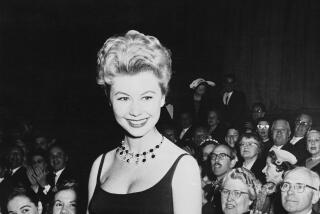A Star Is Torn
As I picked up the galley of this book--”The first authoritative life of one of the most fascinating and enduring personalities of our time,” says Random House--and began to assess the most obvious things about it, I saw that Gerald Clarke had spent 10 years on the task. Ten years! If it was an ordeal being Judy Garland, imagine the plight of those having to look after her, when she was alive--or dead. Or even worse, to be her biographer.
Is there anyone who doesn’t shudder--still moved but appalled at the legendary melodrama--whenever that voice starts up with “Somewhere. . . .”? I need say no more. We all know that hopeless “somewhere” her wide eyes and throbbing voice yearned for. Just as we have tried to forget how, at 47, she was found, stiff already, sitting on a London lavatory she couldn’t afford, by her fifth husband, a discotheque manager.
By my count (in Clarke’s bibliography), there are already 11 biographies of Judy Garland. “Get Happy” by Clarke makes it 12. Some of them may be flimsy and lurid, but so was her life. Books by Anne Edwards, Gerold Frank, Christopher Finch and David Shipman (the most recent, published in 1992) tell Clarke’s story. I have read “Get Happy” with some of the earlier works at hand, and Clarke has little new to offer; his one coup is an interview with Tom Green, one of several younger men who tried to look after the determined disaster in her last years.
Is this enough to justify “authoritative”? Could there ever be a book about so chaotic and disturbed a person that claimed understanding and authority at the same time? Is it enough to keep Clarke--the man who a dozen years ago came out with an excellent, wise and very entertaining book on Truman Capote--going?
It’s not that I seek to deny the horrific fascination of Garland, though I know I would have done a lot to avoid her in person. It’s not even that I dispute the claim that she was one of the greatest entertainers or performers of her time. “Meet Me in St. Louis” is one of my favorite films. But for the price of this book, you could likely buy that and the spoiled but wonderful “A Star is Born,” as well as a CD of her famous live show at Carnegie Hall in 1961. There’s a case to be made for spending an evening with those treasures, instead of suffering once more through the quite gruesome trials and tribulations of this poor woman.
There have always been people and institutions to blame for Garland. Her father, Frank Gumm, was amiable, weak and homosexual, increasingly caught up in scandalous approaches to boys in the theaters he ran in Grand Rapids, Minn. He died early, so Judy missed him and searched for replacements. Her mother, Ethel, was not very affectionate, a driving show biz mom, the first to get her daughter hooked on the rhythm of uppers and downers. There were those drugs, of course, and in the end she died from an overdose. There was the studio, MGM, where the bosses tried to have sex with her while selling her as the girl next door. Then when she became a hit, they overworked her, they bullied her, they wouldn’t let her grow up and tried to run her life. And once they’d used her up, they dumped her.
Clarke laments her chronic talent for finding unsuitable men: the womanizer Artie Shaw; the bland David Rose; an Oscar Levant sicker than she was; the Harvard genius and wife-betrayer Joseph L. Mankiewicz; the bisexual Tyrone Power; the self-centered Orson Welles; the homosexual Vincente Minnelli; the belligerent but uninteresting Sid Luft; the fraudulent David Begelman; the minor actor Mark Herron; and the discotheque manager Mickey Deans. But is it possible to think of any actual man, or conceive of any fantasy figure, who would have been suitable or enough?
The marvel of her life is that so many people did their best for her (that includes writer and musical arranger Kay Thompson and her publicist Betty Asher, who were probably her lovers, too). Her children, at different times, gave up on her and ran away in their pajamas. Even Louis B. Mayer, who groped her and then elevated her while profiting from her, also did what he and the studio could think of to rescue her. The attempts failed, and you can say that they were hypocritical, unimaginative and inconsistent. But recollect how many doctors and shrinks gave up on her, too. And remember that old wisdom from Hollywood health practitioners: There are patients who will kill themselves rather than be healed.
*
In other words, one might as well admit that Garland had an unreasonable and overwhelming need for love, reassurance, adulation and the subsequent mix of self-pity and paranoia that could turn any attempt at care into a threat to her body and soul. Thus, it’s hard for most people to grasp how, in 1946, when MGM offered her a new contract in which her salary was nearly doubled for just two films a year, she was able to translate that into further proof of the studio’s hostility.
Yes, MGM was a tough factory, where her bosses were the odious Mayer and the slobby Arthur Freed. But MGM also offered her Mickey Rooney, Gene Kelly, Fred Astaire, Minnelli, Charles Walters, Roger Edens, Thompson and so on. Sure, the studio tried to flatten her breasts and keep her Andy Hardy’s pal for too long. But the same studio had given her Dorothy, the rainbow song, “The Wizard of Oz” and Minnelli as a husband. He was a liability as a lover, but he made her beautiful in “Meet Me in St. Louis.” He gave her Margaret O’Brien and the Christmas night scene. He saved “The Clock” for her. He offered the example of losing personal confusion in constant work. And in the same period of time, Shirley Temple and Deanna Durbin went through the Hollywood factory, survived and are still with us. If Garland ended up a wreck, maybe wreckage was her destiny.
I think that Clarke is correct in stressing how slowly MGM came to realize what Judy was good for. No matter how great her talent, the best way of using it was not obvious. Even before she got into pictures, on the variety stage, she was a child who sang like a woman. That’s not easy to reconcile. How does the child know so much? Is the innocence fake? Does it make her a kind of Lolita?
Judy Garland was not beautiful for very long. The aura of beauty may have owed more to Minnelli than to Judy’s rather greedy gaze. She had an awkward figure and a lifelong tendency to put on weight. And while it is true that as a singer she was a great actress--like Piaf or Sinatra--I’m not sure that she was an assured actress without songs.
After things with MGM finally broke down in 1950, she made only four more films. In two of those, “Judgment at Nuremberg” and “A Child Is Waiting,” she is ordinary. In the other two, “A Star Is Born” and “I Could Go On Singing,” she was playing herself. And in “A Star Is Born,” this makes for problems: She’s too old and too world-weary for that ingenue role. She’s plainly no longer ravishing or camera-friendly; it may even be that her charm and energy came from “live” performance. I wonder whether, if life had taken a different turn, she could have played Margo Channing, the Bette Davis part in “All About Eve” or the kind of roles carried by Joan Crawford, Susan Hayward and Jane Wyman. Could she have done non-singing roles? Or might she have been great as the mother in “Gypsy”?
As I read Clarke’s book, I felt his coverage of the MGM years was a little automatic. In “Capote” there was never any doubt but that he relished the wit, the writing and the style of his subject. I’m not so sure that Judy on screen is quite Clarke’s cup of tea. But his narrative picks up in the ‘50s and ‘60s as she becomes a live performer--with exciting triumphs at the London Palladium, the Palace in New York, in Las Vegas and then at Carnegie Hall. And maybe that’s when Judy was most herself and closest to happy: commanding a room and a gathering of strangers who could convince her that they loved her.
As for the rest, there’s too much here that is both sickly and painfully repetitive. Clarke doesn’t believe that Judy was wronged or hounded to her end. I don’t see how anyone could trace the facts and come to that conclusion. So one may feel horror but hardly sympathy or shock. She was the relentless drive in her own destruction--and such people, in life and in the 10th, 11th and 12th biographies, cannot escape being pains in the neck. When we’ve reached that point, I’d rather hear the old songs and see the amber fall of her hair in “Meet Me in St. Louis,” in which the Smith family elects to take no great risks, to give up on the dream of New York and to stay home in good old St. Louis. In so many American lives, doing nothing is the best chance of happiness.
More to Read
Sign up for our Book Club newsletter
Get the latest news, events and more from the Los Angeles Times Book Club, and help us get L.A. reading and talking.
You may occasionally receive promotional content from the Los Angeles Times.







